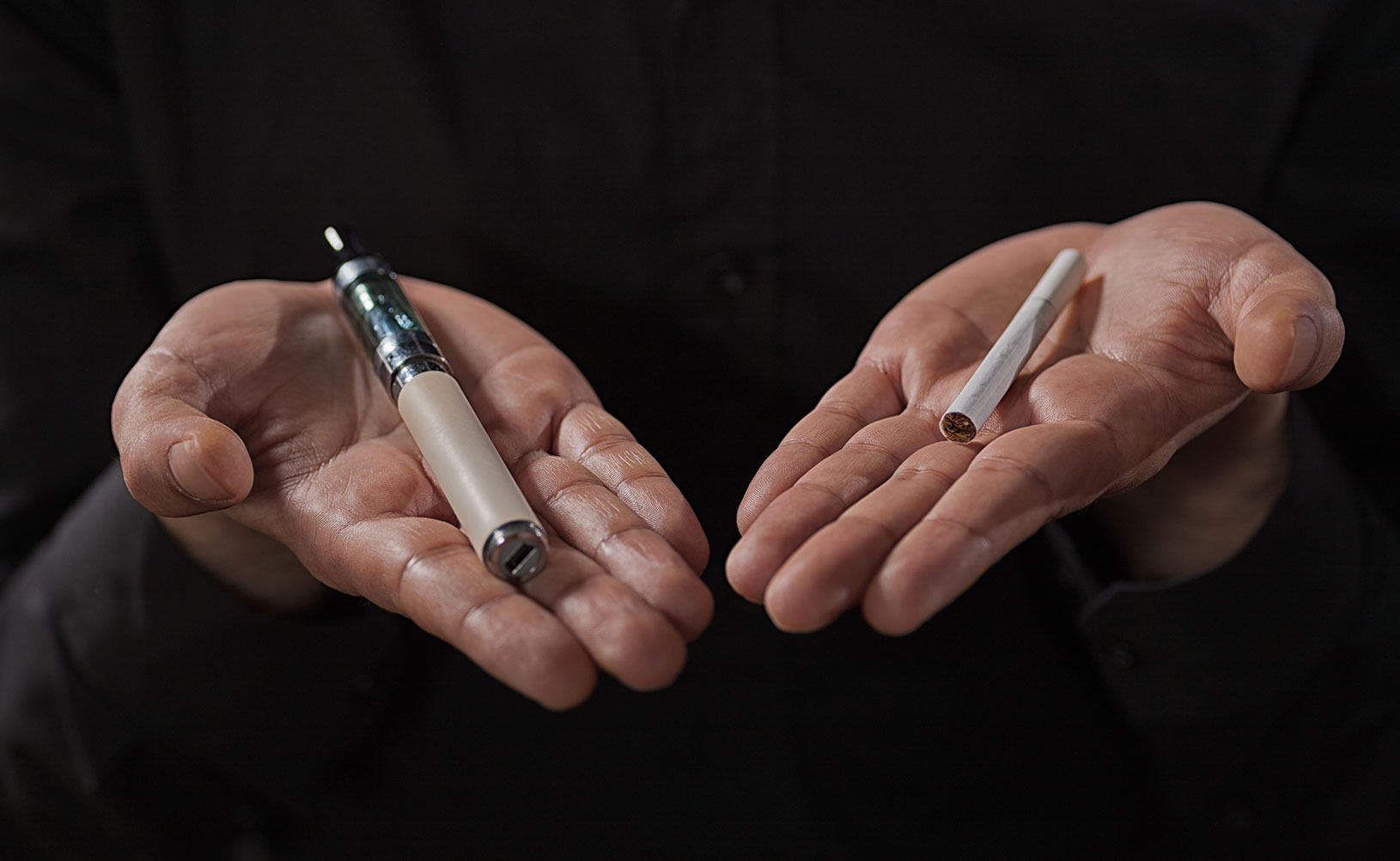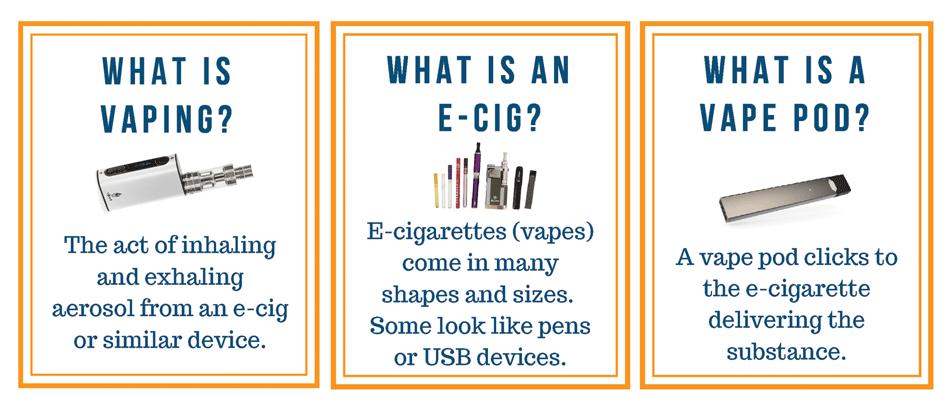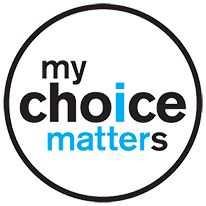KNOW THE FACTS
E-Cigarettes, Vaping, & Nicotine

Also known as:
Cigarettes: Smokes, Cigs, or Butts
Smokeless tobacco: Chew, Dip, Spit Tobacco, Snus, or Snuff
Hookah: Waterpipe, Narghile, Shisha, Hubble-bubble, or Goza
Tobacco is a leafy plant grown around the world, including in parts of the United States. There are many chemicals found in tobacco leaves or created by burning them (as in cigarettes), but nicotine is the ingredient that can lead to addiction. Other chemicals produced by smoking, such as tar, carbon monoxide, acetaldehyde, and nitrosamines, also can cause serious harm to the body. For example, tar causes lung cancer and other serious diseases that affect breathing, and carbon monoxide can cause heart problems.
Teens who are considering smoking for social reasons should keep this in mind: Tobacco use is the leading preventable cause of disease, disability, and death in the United States. According to the Centers for Disease Control and Prevention (CDC), cigarettes cause more than 480,000 premature deaths in the United States each year—from smoking or exposure to secondhand smoke—about 1 in every 5 U.S. deaths, or 1,300 deaths every day.
Tobacco and nicotine products come in many forms. People can smoke, chew, sniff them, or inhale their vapors.
Smoked tobacco products
- Cigarettes (regular, light, and menthol): No evidence exists that “lite” or menthol cigarettes are safer than regular cigarettes.
- Cigars and pipes: Some small cigars are hollowed out to make room for marijuana, known as "blunts." Some young people do this to attempt to hid the fact that they are smoking marijuana. either way, they are inhaling toxic chemicals.
- Bidis and kreteks (clove cigarettes): Bidis are small, thin, hand-rolled cigarettes primarily imported to the United States from India and other Southeast Asian countries. Kreteks—sometimes referred to as clove cigarettes—contain about 60-80% tobacco and 20-40% ground cloves. Flavored bidis and kreteks are banned in the United States because of the ban on flavored cigarettes.
- Hookahs or water pipes: Hookah tobacco comes in many flavors, and the pipe is typically passed around in groups. A recent study found that a typical hookah session delivers approximately 125 times the smoke, 25 times the tar, 2.5 times the nicotine, and 10 times the carbon monoxide as smoking a cigarette.
Smokeless tobacco products
The tobacco is not burned with these products:
- Chewing tobacco. It is typically placed between the cheek and gums.
- Snuff: Ground tobacco that can be sniffed if dried or placed between the cheek and gums.
- Dip: Moist snuff that is used like chewing tobacco.
- Snus: A small pouch of moist snuff
- Dissolvable products (including lozenges, orbs, sticks, and strips)
Electronic cigarettes
(also called e-cigarettes, electronic nicotine delivery systems, or e-cigs)
Electronic cigarettes are battery-operated devices that deliver nicotine and flavorings without burning tobacco. In most e-cigarettes, puffing activates the battery-powered heating device, which vaporizes the liquid in the cartridge. The resulting vapor is then inhaled, called vaping.
Like other drugs, nicotine increases levels of a neurotransmitter called dopamine. Dopamine is released normally when you experience something pleasurable like good food, your favorite activity, or spending time with people you care about. When a person uses tobacco products, the release of dopamine causes similar effects. This effect wears off quickly, causing people who smoke to get the urge to light up again for more of that good feeling, which can lead to addiction.
A typical smoker will take 10 puffs on a cigarette over the period of about 5 minutes that the cigarette is lit. So, a person who smokes about 1 pack (25 cigarettes) daily gets 250 “hits” of nicotine each day.
Studies suggest that other chemicals in tobacco smoke, such as acetaldehyde, may increase the effects of nicotine on the brain.
When smokeless tobacco is used, nicotine is absorbed through the mouth tissues directly into the blood, where it goes to the brain. Even after the tobacco is removed from the mouth, nicotine continues to be absorbed into the bloodstream. Also, the nicotine stays in the blood longer for users of smokeless tobacco than for smokers.
E-cigarettes have only been around for just over ten years, so researchers are in the early stage of studying how they affect your health.
E-cigarettes are designed to deliver nicotine without the other chemicals produced by burning tobacco leaves. Puffing on the mouthpiece of the cartridge activates a battery-powered inhalation device (called a vaporizer). The vaporizer heats the liquid inside the cartridge which contains nicotine, flavors, and other chemicals. The heated liquid turns into an aerosol (vapor) which the user inhales—referred to as “vaping.”
Health experts have raised many questions about the safety of these products, particularly for teens:
- Testing of some e-cigarette products found the aerosol (vapor) to contain known cancer-causing and toxic chemicals, and particles from the vaporizing mechanism that may be harmful. The health effects of repeated exposure to these chemicals are not yet clear.
- There is animal research which shows that nicotine exposure may cause changes in the brain that make other drugs more rewarding. If this is true in humans, as some experts believe, it would mean that using nicotine in any form would increase the risk of other drug use and for addiction.
- Some research suggests that e-cigarette use may serve as a “gateway” or introductory product for youth to try other tobacco products, including regular cigarettes, which are known to cause disease and lead to early death. A recent study showed that students who have used e-cigarettes by the time they start 9th grade are more likely than others to start smoking traditional cigarettes and other smoked tobacco products within the next year.
- The liquid in e-cigarettes can cause nicotine poisoning if someone drinks, sniffs, or touches it. Recently there has been a surge of poisoning cases in children under age 5. There is also concern for users changing cartridges and for pets.
- Some research shows that secondhand e-cig vapor pollutes the air quality with particles that could harm the lungs and heart.
- Some research suggests that certain brands of e-cigs contain metals like nickel and chromium, possibly coming from the heating of coils.
Are e-cigarettes regulated?
Yes. The U.S. Food and Drug Administration (FDA) announced in 2016 that the FDA will now regulate the sales of e-cigarettes, hookah tobacco, and cigars. Therefore:
- It is now illegal to sell e-cigarettes, hookah tobacco, or cigars in person or online to anyone under age 18.
- Buyers must show their photo ID to purchase e-cigarettes, hookah tobacco, or cigars, verifying that they are 18 years or older.
- These products cannot be sold in vending machines (unless in an adult-only facility).
- It is illegal to hand out free samples.
FDA regulation also means that the Federal government will now have a lot more information about what is in e-cigarettes, the safety or harms of the ingredients, how they are made, and what risks need to be communicated to the public (for example, on health warnings on the product and in advertisements). They will also be able to stop manufacturers from making statements about their products that are not scientifically proven.
Regulation does not mean that e-cigarettes are necessarily safe for all adults to use, or that all health claims currently being made in advertisements by manufactures are true, but it does mean that e-cigarettes, hookah tobacco, and cigars now follow the same type of rules as cigarette manufacturers.
When asked why they vape, many teens said:
- to experiment (60.9%)
- because it tastes good (41.7%)
- to have a good time with friends (37.9%)
- to relax and relieve tension (37.4%) – representing an increase of nearly one-third since 2018
- to feel good or get high (29.0%)
- boredom (28.7%)
- it looks cool (15.2%)
- because they’re “hooked” (8.1%) which doubled from 2018 (3.6%)
- to help quit regular cigarettes (6.1%)
- regular cigarette use is not permitted (3.3%)

Drug Facts About Vaping
National Institute on Drug Abuse (NIH)
Tips for Teens: The Truth About Tobacco
Tips for Teens: The Truth about E-Cigarettes
Substance Abuse and Mental Health Services Administration (SAMHSA)

